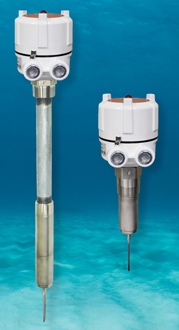The BinMaster VR series vibrating rod level switch is used to detect high-, midand/or low-levels in bins, silos, tanks and hoppers or can be used for plugged chute detection.
It is most commonly used to detect the level of powders or dry bulk solid materials. It can be used in extremely light, fluffy materials with bulk densities as low as 1.25 lb. /cu. ft. and in material with low dielectric constants. It is a proven performer in carbon black, plastics, fly ash, feed, seed, grain, food, chemicals as well as many other materials.
As a reliable point level indicator, the vibrating rod sends an alarm to a horn or alarm panel to alert personnel when the material level has reached the probe.
Unique Single-Blade Design
BinMaster’s single-rod probe features a sword-shaped probe that resists bridging of material that can occur with tuning forks designs. Due to its sleek design, the material falls around the probe and won’t build up. This piezoelectric-driven vibrating rod has very low energy, so it won’t “dig a hole” in the material and cause a false alarm.
BinMaster’s vibrating rod is easy to install, mounting to the vessel via a standard 1-1/2” NPT mounting socket and requires no calibration. It has an auto sensing power supply which can accommodate 20 – 250 volts AC/DC and dual conduit entries for easy wiring. A convenient screw-off cap provides easy access to electronic components. The LED status indicator light indicates sensor status and a switch-selectable, high/low fail-safe alerts to power failures. Remote electronics are available for applications with excessive vibration or heat.
The Long and the Short of it
The VR-21 model has a standard 7.37” probe and can be used for low-, midand high-level detection. It is commonly mounted on the side or in the cone of the tank. Additionally, BinMaster offers two extendable vibrating rods for top mounting applications when the device is used for high level detection. The VR-41 features a rigid, extended 1” pipe extension made of galvanized or stainless steel that can be custom made in lengths from 13” up to 13’. The VR-51 uses a flexible steel rope reinforced cable and allows for insertion lengths up to 19’. Both models of the extendable units are factory sized to customer specifications.
Playing it Safe in Hazloc
As hazardous location approvals are a requirement for sensors used in many facilities in the United States and Canada, hazardous location approvals on the Bin- Master VR-21 and VR-41 vibrating rods provide facilities another option when they need a level indicator to use in dusty environments. The standard VR-21 vibrating rod level sensor and rigid extended VR-41 vibrating rod level sensor are available with hazardous locations approvals in the US and Canada to CSA standards for Class II, Division I, Groups E, F, and G. Enclosure type certifications for these models include NEMA 4X, 5 and 12.
Measure Sediment under Liquid
Another unique application for the BinMaster vibrating rod is to measure the level of solid material that has settled in a tank containing liquids. Used to detect when a layer of solid material reaches a specific level in a tank, the VR SED (for sediment) vibrates in water and then stops vibrating when the solid material reaches the level of the probe. It is commonly used in the water and wastewater industry to detect the level of salt, lime, carbon and silt that has settled in tanks at water treatment plants.
 VR-21 SED and VR-41 SED for measuring sediment under liquid.
VR-21 SED and VR-41 SED for measuring sediment under liquid.
The VR SED can also be used in food and beverage manufacturing, chemical or metal processing, pulp and paper making, and at mining operations. Applications include measuring sediment in brine tanks or soak tanks, detecting sand or silt that has settled in tanks at quarries or mines, timely removal of sand and dirt at pumping stations, or measuring manure or compost that has settled in refuse vessels.
Alternative uses include detecting the level of materials such as ash, carbon, lime, silt and mud once they have settled under water. Another common use for the VR SED is to detect coarse and fine sediment in tanks at hydroelectric power stations. In these tanks, it is important to prevent sediment from reaching the level of the turbines.
Detecting sediment before it reaches the turbines allows settled debris to be removed automatically before it interferes with their operation and helps extend the service life of the turbines. The VR SED vibrating rod is available in two different models. The VR-21 SED is the standard model with a 7.37” insertion length and is recommended for use on the tank wall. The VR-41 SED model is a rigid extended vibrating rod for top mounting applications and is custom made with extensions from 13” up to 13’ long, dependent on the needs of the application.